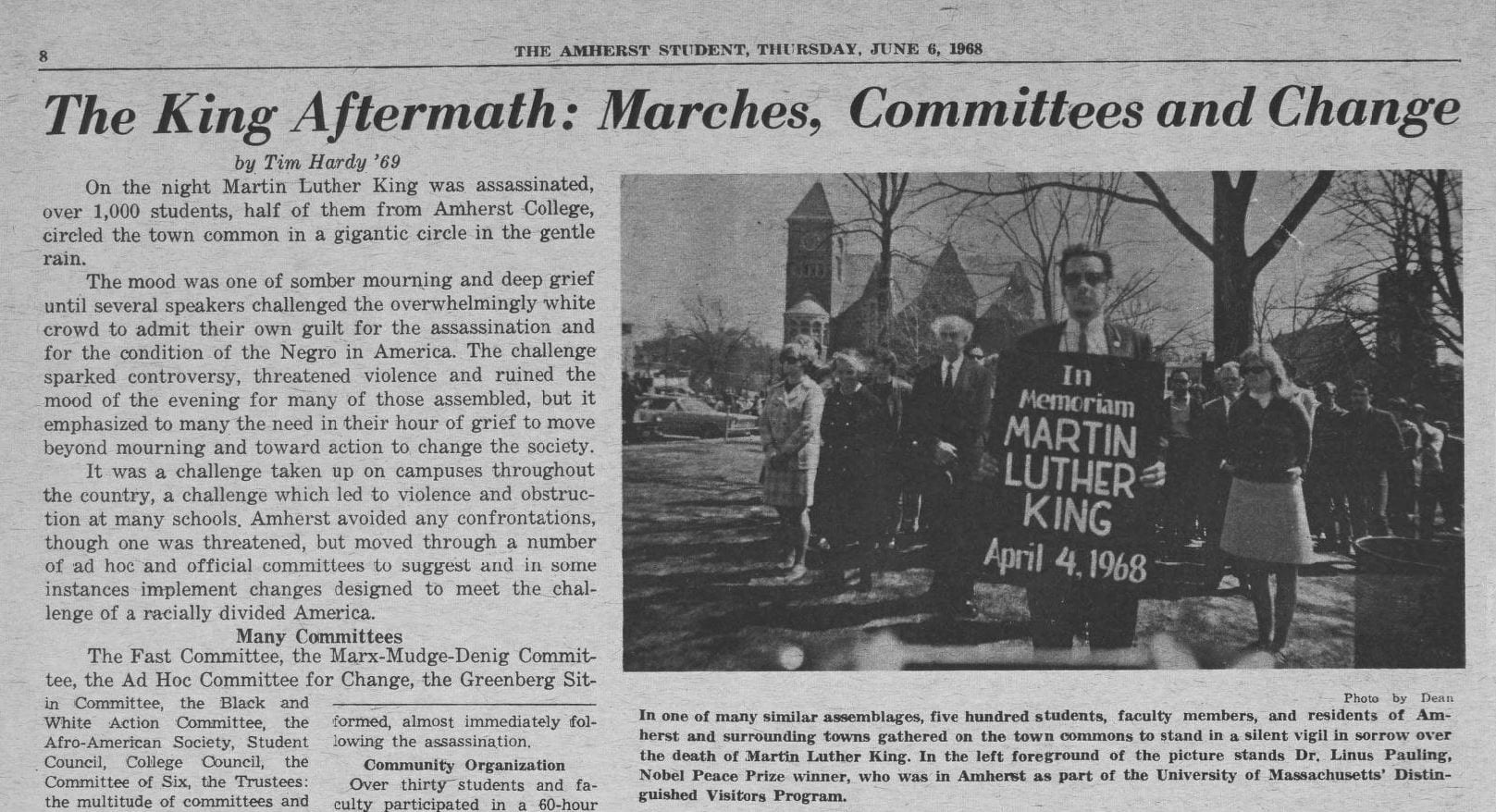At the Amherst College Library, we’ve been preparing for the College’s bicentennial in 2020-21 for several years. We’ve prioritized digitizing materials like the student newspapers, the yearbooks, and the catalogs because they contain a rich combination of data and anecdotes about the College, its students, its faculty, and sometimes its staff for a wide swath of the institution’s almost-200 year history. We’re aware that as the bicentennial approaches, many researchers, alumni, and other interested parties will want to dig in to the College’s history, and having these materials online gives them faster and easier access to that history. It also saves the folks in the Archives from having to respond in-depth to inquiries like “How did Amherst students react to Rev. Dr. Martin Luther King Jr.’s assassination?” (take a look at the Amherst Student issues from 1968-70, which include immediate reactions and also coverage of the protests that led to the formation of the Black Studies department) or “What courses were being taught at Amherst in 1945-46?” (check out the catalog from that year).
Beginning in the spring of 2017, our work on this bicentennial project has intensified. Through a combination of a retirement and generous funding from the Dean of Faculty’s office, we have been able to hire a Bicentennial Project Archivist (Jennifer Bolmarcich), a Digitization Coordinator (Timothy Pinault), and a Bicentennial Project Metadata Librarian (Amanda Wise Pizzollo). These three folks have jump-started our digitization pipeline, and their help has led us to set the ambitious goal of digitizing 24 collections in part or whole by the start of the bicentennial.
These three new employees also represent a microcosm of our digitization workflow. Our projects start in the Archives & Special Collections, where the material we digitize lives. Folks in the Archives take in, organize, and describe a wide range of material related to the history of the College, as well as materials in subject areas taught at the College which are used by faculty in their teaching. Their expertise and in-depth knowledge of their holdings also helps guide conversations about what collections we should digitize, since they know what is in highest demand by researchers, as well as what would likely get more attention if it were more freely available. Jen will be spending a lot of time with legacy collections in the Archives which need a large-scale re-organization to bring them up to modern archival standards. Archives’ organization and initial description of the collections also helps set the stage for the other two departments involved in our digitization projects.
The Digital Programs department handles the next step of the process, which is digitization. Tim starts with the finding aid created by Archives, and surveys the collection or series to be digitized, identifying any questions, problematic materials, or preservation concerns. Once all questions about the collection are resolved, the project is assigned to one of our student workers, who photographs the materials on one of our camera stands. Another student worker then crops and checks the materials to make sure everything looks as it should, and Tim does a final review. At that point, the materials are ready for metadata.
The metadata unit within the Technical Services department describes all of our digitized material following national and local standards, guidelines, and procedures. Our metadata creators (primarily Manda) create a metadata record for every digitized item in the collection. This process starts with a review of the finding aid created by Archives to get an initial understanding of the collection, an understanding that develops as they work to describe each item in the collection. Throughout the process, metadata creators work closely with Archives and Digital Programs. The metadata records they create capture descriptive information about each item that helps to place it in the context of the archival collection as well as facilitate online discovery by including abstracts and subjects. The Metadata Management Librarian does a final review of the records for quality control and consistency, and then they are passed back to Digital Programs to package the metadata with the images for our developers, who ingest the collection into Amherst College Digital Collections.
This is a very simplified overview of our process. There’s a lot of communication at every step of the process, especially in between when a collection has been identified for digitization, and when Digital Programs actually starts photographing the materials. We’re excited to share more about our processes and our team with you in the coming months and years!
Sarah Walden McGowan is the Digital Collections and Preservation Librarian at Amherst College. She oversees digitization of archival materials, does planning and policy creation for digital preservation, and thinks a lot about born digital objects. She can be reached at swaldenmcgowan (at) amherst.edu.
